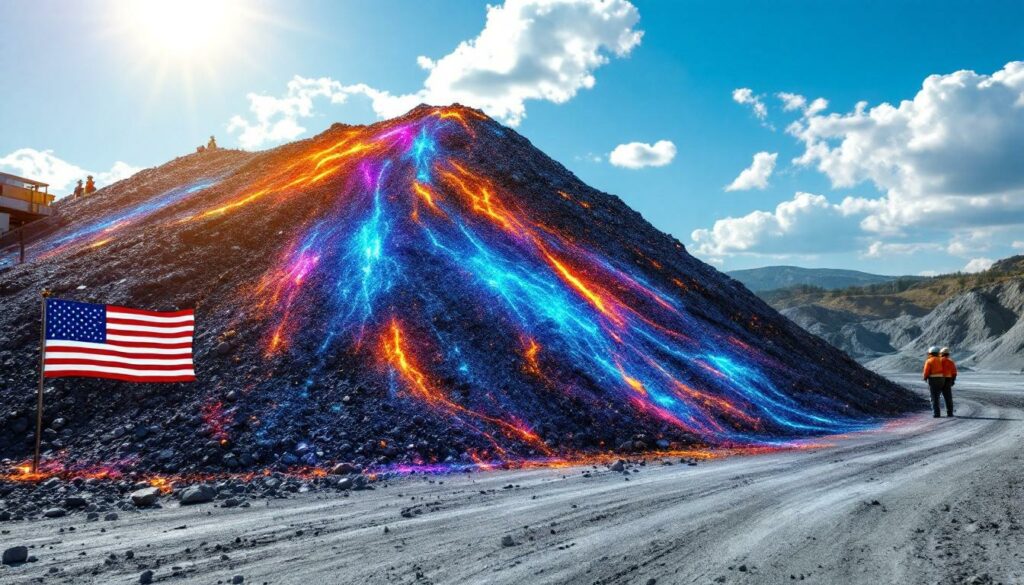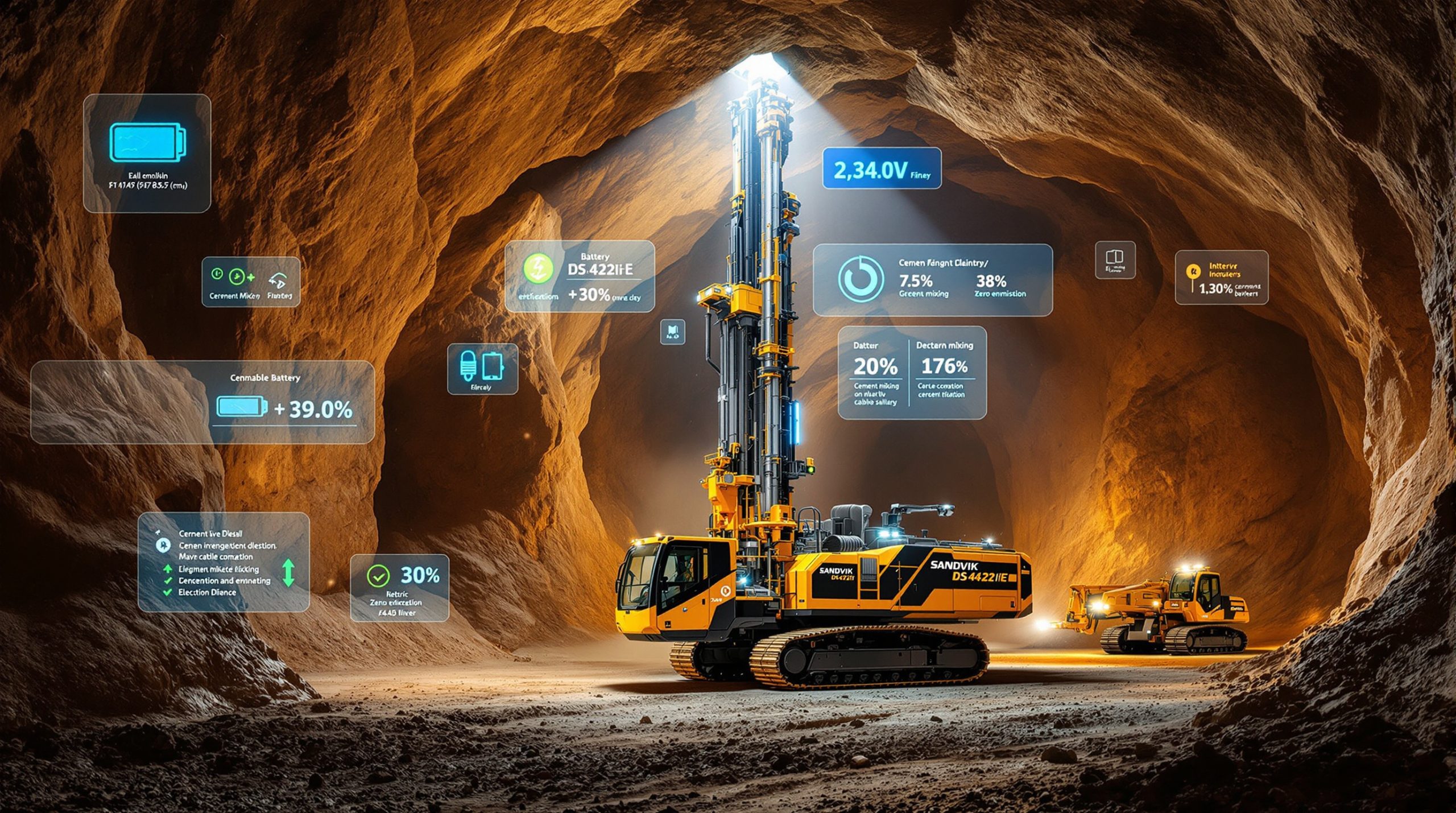The Strategic Importance of Mine Waste Reclamation
Why Mine Waste Recovery Matters for National Security
America's national security and economic resilience increasingly depend on securing domestic supplies of critical minerals. The Department of Interior's innovative initiative to recover minerals from mine waste addresses this strategic imperative while potentially remediating environmental hazards from historical mining operations.
Recent assessments reveal that mine waste sites across the United States contain an estimated $2.5 billion in recoverable minerals at the Coeur d'Alene site in Idaho alone. This approach aligns perfectly with national objectives to reduce foreign mineral dependency and strengthen domestic production capacity.
"By streamlining regulations for extracting critical minerals from mine waste, we are unleashing the full potential of America's mineral resources to bolster national security and economic growth," notes Acting Assistant Secretary Adam Suess, highlighting the dual benefits of this strategy.
The Economic Potential of Mine Waste
What was once considered worthless mining debris now represents a significant economic opportunity as extraction technologies advance and mineral prices rise. Abandoned mines and processing tailings across America contain billions of dollars worth of recoverable resources that can transform environmental liabilities into valuable assets.
The economic impact extends beyond direct mineral recovery. These projects create specialized jobs in mineral processing, environmental remediation, and advanced extraction technologies—particularly beneficial for regions affected by mining downturns where expertise already exists.
Industry Insight: Unlike traditional mining that may take decades to develop, mineral recovery from waste can begin producing critical materials within 1-3 years, providing a rapid response to supply chain vulnerabilities.
What Executive Actions Are Driving This Initiative?
Department of Interior's Strategic Directive
The Department of Interior, under Secretary Doug Burgum's leadership, has implemented a comprehensive directive aimed at accelerating critical mineral recovery from mine waste sites. This initiative represents a coordinated federal approach that prioritizes:
- Streamlining regulatory frameworks for critical mineral extraction from legacy waste
- Updating guidance for federal funding eligibility to support recovery projects
- Directing the USGS to conduct comprehensive mapping and inventory of federal mine waste sites
- Focusing explicitly on uranium recovery from abandoned mines to support energy security
This strategy leverages existing disturbed land rather than developing new mines, potentially reducing permitting timelines from decades to just a few years in some cases.
Alignment with Presidential Priorities
The mine waste recovery directive directly supports Trump's critical minerals order aimed at strengthening America's mineral independence. Acting Assistant Secretary Scott Cameron emphasized that "recovering critical minerals from mine waste is integral to strengthening America's mineral independence while promoting economic growth and national security."
By focusing on waste recovery rather than solely new extraction, this approach offers a potentially faster pathway to mineral security while addressing environmental concerns associated with historical mining operations—creating a win-win solution for both industry and communities.
Where Are the Most Promising Mine Waste Resources Located?
Key Recovery Sites Across America
Through collaborative research between the USGS and state geological surveys, several high-potential sites have been identified across the country:
| Location | Waste Source | Recoverable Minerals | Estimated Value/Potential |
|---|---|---|---|
| Tar Creek, Oklahoma | Legacy lead/zinc mining | Zinc, germanium | Significant import replacement potential |
| Bingham Canyon, Utah | Copper mining tailings | Tellurium | Essential for defense technologies |
| Coeur d'Alene, Idaho | Silver mining waste | Antimony, arsenic, precious metals | Approximately $2.5 billion |
| Appalachian/Illinois Basins | Coal deposits | Rare earth elements | Critical for advanced technologies |
These sites represent just the beginning of what could become a nationwide network of mineral recovery operations leveraging previously discarded materials.
The Earth Mapping Resources Initiative
The Earth Mapping Resources Initiative is revealing promising new mineral opportunities throughout Appalachia and the Midwest through advanced 3D geological modelling techniques. These discoveries are particularly significant for economically challenged regions still recovering from the decline of traditional coal and metal mining operations.
Using cutting-edge geophysical surveys and data analytics, geologists are identifying concentrated deposits of critical minerals within waste piles that were overlooked during initial mining operations, when these elements had limited commercial value.
Technical Insight: Modern imaging technology can detect mineral concentrations at parts-per-million levels that were impossible to identify when these mines were originally operating.
What Minerals Are Being Targeted for Recovery?
Strategic Elements in Mine Waste
The recovery initiative focuses on several high-value minerals present in significant quantities within mine waste:
-
Zinc and Germanium: Found in legacy lead and zinc mining operations like Tar Creek, Oklahoma, these minerals are typically imported but available domestically in waste streams. Germanium is essential for fiber optics, infrared optics, and solar cell applications.
-
Tellurium: This rare element, recoverable from copper mining tailings at sites like Bingham Canyon, Utah, is critical for producing thin-film solar panels and next-generation electronic devices. It's also essential for various defense technologies.
-
Antimony and Arsenic: Present in silver mining waste at Coeur d'Alene, Idaho, antimony is crucial for flame retardants, batteries, and semiconductor manufacturing. The site's estimated $2.5 billion in recoverable minerals makes it one of the most valuable waste resources in the country.
-
Rare Earth Elements (REEs): Found in clay deposits within coal seams across the Appalachian and Illinois Basins, REEs like neodymium, dysprosium, and praseodymium are irreplaceable components in renewable energy technologies, advanced electronics, and defense systems.
-
Uranium: Specifically prioritized for recovery from abandoned mines to support energy security and reduce dependence on foreign sources for nuclear fuel. The uranium market dynamics have made this recovery increasingly economical.
Industry Perspective: Many of these minerals were considered worthless impurities when the original mines operated, but technological advances have transformed them into some of the most valuable elements in modern manufacturing.
How Will Regulatory Changes Facilitate Recovery?
Streamlining the Regulatory Framework
The Department's directive aims to remove unnecessary regulatory barriers while maintaining essential environmental safeguards. Key aspects include:
-
Updating permitting processes specifically for waste recovery operations, recognizing that disturbing already-mined material presents different challenges than new extraction
-
Establishing clear guidelines for private sector investment in mine waste reclamation, creating certainty for businesses considering these projects
-
Creating pathways for federal funding eligibility for innovative recovery projects that demonstrate both economic and environmental benefits
-
Developing standardized environmental assessment protocols specifically tailored for waste recovery operations rather than applying new-mine standards
These changes address one of the primary challenges facing the mining industry: regulatory uncertainty that can extend project timelines and increase costs unpredictably.
Public-Private Partnership Opportunities
The initiative creates new avenues for collaboration between government agencies, private industry, and research institutions through innovative partnership models:
-
Data sharing agreements where USGS provides geological assessments that companies can use to target high-potential waste sites
-
Technology development collaborations between national laboratories and private companies to advance extraction techniques
-
Risk-sharing structures where government assumes certain environmental liabilities while private companies invest in recovery operations
-
Academic partnerships leveraging university research to solve technical challenges in mineral separation and recovery
These partnerships maximize public resources for mapping and assessment while enabling private sector innovation and investment in actual recovery operations—a model that's proving more efficient than either sector working alone.
What Technologies Enable Efficient Mineral Recovery?
Advanced Extraction Methodologies
Modern mineral recovery from waste employs sophisticated technologies that weren't available during original mining operations:
-
Bioleaching processes use specialized bacteria to dissolve and separate metals from waste rock with minimal environmental impact
-
Precision physical separation techniques like multi-stage flotation cells can isolate valuable minerals from complex waste matrices at previously impossible concentrations
-
Advanced hydrometallurgical methods use environmentally responsible chemical processes that minimize additional impact while maximizing recovery rates
-
Real-time X-ray fluorescence (XRF) analysis systems optimize recovery rates by providing immediate feedback on mineral content during processing
-
Energy-efficient grinding and classification systems reduce power consumption while improving mineral liberation from waste particles
These technologies make it possible to economically extract minerals at concentrations that would have been considered far too low for recovery when the original mining occurred.
Environmental Benefits of Modern Recovery
Contemporary mineral recovery techniques often significantly improve environmental conditions at legacy sites by:
-
Removing potentially harmful elements like arsenic, lead, and cadmium from the environment
-
Reducing acid mine drainage through waste processing that neutralizes acid-generating materials
-
Stabilizing tailings piles and waste rock dumps that present physical hazards to nearby communities
-
Potentially enabling full site remediation after valuable minerals are extracted
-
Minimizing water consumption through closed-loop processing systems that recycle process water
In many cases, the environmental benefits alone might justify recovery projects, with the mineral value providing the economic incentive to undertake what would otherwise be costly remediation work.
What Economic Benefits Will This Initiative Create?
Job Creation and Economic Revitalization
The recovery initiative promises significant economic benefits for mining communities across America:
-
Creation of skilled, high-paying jobs in mineral processing, environmental sciences, and advanced manufacturing
-
Development of technical expertise in recovery methodologies that can be exported globally
-
Establishment of new processing facilities in regions with abundant mine waste, often in economically distressed areas
-
Revitalization of support industries including equipment manufacturing, transportation, and technical services
-
Potential for downstream manufacturing growth based on reliable domestic mineral supplies
These benefits are particularly valuable in former mining regions where economic alternatives have been limited since traditional operations ceased.
Strengthening Domestic Supply Chains
By recovering critical minerals domestically, the initiative addresses fundamental supply chain vulnerabilities:
-
Reduces dependence on imports from geopolitical competitors for essential manufacturing inputs
-
Creates price stability for American manufacturers by establishing reliable domestic sources
-
Supports national defense requirements with secure mineral sources for military technologies
-
Enables expansion of renewable energy manufacturing by securing rare earth elements and other critical minerals
-
Provides feedstock for advanced technology development in sectors ranging from electric vehicles to telecommunications
This domestic supply security becomes increasingly important as global competition for limited mineral resources intensifies.
How Does This Approach Compare to Traditional Mining?
Advantages Over New Extraction
Recovering minerals from existing waste offers several compelling advantages compared to developing new mines:
-
Significantly shorter timeline from project initiation to mineral production—often 1-3 years versus a decade or more
-
Reduced permitting complexity when working with existing disturbed areas rather than pristine sites
-
Lower capital requirements compared to developing new underground or open-pit mines
-
Smaller physical footprint than new mining operations, often confined to already-disturbed land
-
Potential environmental improvements through proper waste remediation during recovery
These advantages make waste recovery an attractive option for addressing near-term mineral supply challenges while longer-term mining projects develop.
Complementary Approach to Mineral Security
The waste recovery initiative complements rather than replaces traditional mining, creating a multi-faceted approach to mineral security that:
-
Provides near-term mineral supply while new mines navigate lengthy development timelines
-
Maximizes the value of historical mining investments by extracting previously overlooked resources
-
Creates diverse mineral sources to enhance overall supply reliability
-
Develops expertise applicable to both waste recovery and new mining operations
-
Establishes processing infrastructure that can later handle materials from new domestic mines
This balanced approach recognizes that both waste recovery and mine reclamation innovation will be necessary to meet America's growing mineral demands.
What Challenges Must Be Overcome?
Technical and Economic Hurdles
Despite its promise, mineral recovery from waste faces several significant challenges:
-
Variable mineral concentrations that may complicate consistent recovery operations
-
Complex waste matrices requiring sophisticated separation technologies to isolate valuable components
-
Economic uncertainties related to processing costs versus fluctuating mineral values
-
Potential contamination issues requiring careful management during recovery operations
-
Scale-up challenges when moving from laboratory to commercial operations
-
Degradation of certain minerals through weathering and oxidation in exposed waste piles
Addressing these challenges requires innovative approaches combining geological expertise, advanced processing technology, and creative business models.
Balancing Environmental Considerations
The initiative must carefully navigate environmental concerns to achieve its dual objectives:
-
Ensuring recovery operations don't create new environmental problems while addressing existing issues
-
Managing potential disturbance of stabilized waste sites that may have reached environmental equilibrium
-
Addressing community concerns about renewed activity at legacy sites with problematic histories
-
Developing appropriate end-state remediation plans for processed sites
-
Balancing recovery efficiency against environmental impact to maximize overall benefit
Success requires transparent engagement with communities, rigorous environmental monitoring, and modern mining ESG strategies throughout the recovery process.
FAQ: Critical Mineral Recovery from Mine Waste
What makes a mineral "critical" to the United States?
Critical minerals are those essential for economic and national security that face supply chain vulnerabilities. The official list includes 50 minerals crucial for renewable energy technologies, defense systems, and advanced manufacturing that currently rely heavily on foreign sources. Many of these—like rare earth elements, germanium, and tellurium—are available in domestic mine waste.
How does mine waste recovery support environmental goals?
While primarily focused on mineral security, waste recovery can simultaneously address environmental liabilities by removing potentially harmful elements from abandoned sites, stabilizing waste piles, and potentially funding complete site remediation through mineral sales. The process often reduces acid mine drainage and improves water quality in surrounding watersheds.
Will this initiative reduce the need for new mines?
The initiative complements rather than replaces new mine development. While waste recovery provides near-term mineral supplies, growing demand for critical minerals will still require responsible development of new mining operations. However, waste recovery may reduce pressure to expedite new mines by providing bridge supplies during development periods.
How can private companies participate in this initiative?
Private companies can engage through partnerships with federal agencies, applying for updated funding programs, participating in research collaborations, and developing proposals for specific waste recovery projects at identified high-potential sites. The streamlined regulatory framework specifically aims to make private investment more attractive and predictable.
What timeline is expected for seeing results from this initiative?
Initial projects could begin producing minerals within 1-3 years, significantly faster than new mine development. The comprehensive mapping and inventory process will continue to identify new opportunities over a 5-10 year timeframe, creating a pipeline of projects that can be developed as technology and market conditions evolve.
Ready to Get Alerts on the Next Major Mineral Discovery?
While America focuses on recovering minerals from mine waste, Discovery Alert's proprietary Discovery IQ model provides real-time alerts on significant ASX mineral discoveries, giving investors a crucial edge in identifying potentially transformative opportunities. Explore how historic discoveries have generated substantial returns by visiting Discovery Alert's dedicated discoveries page.




